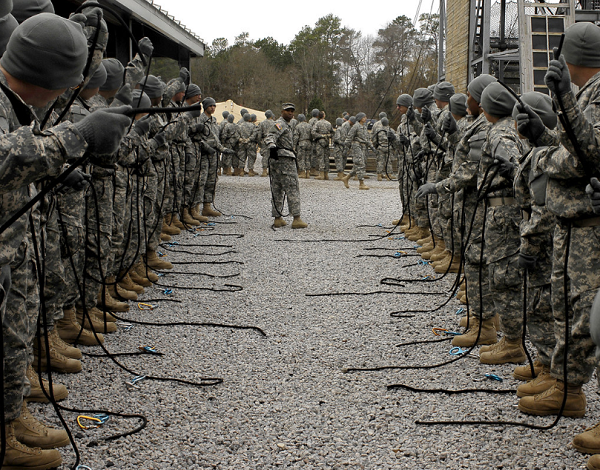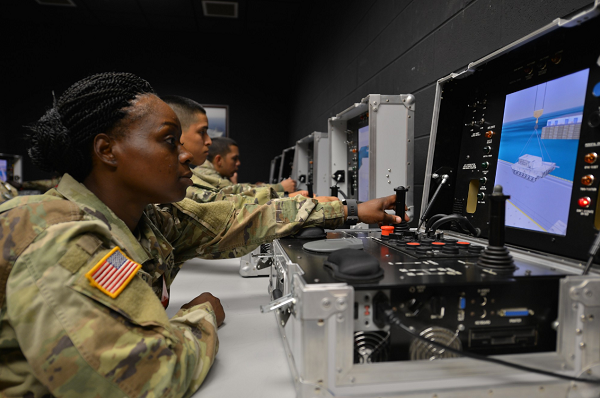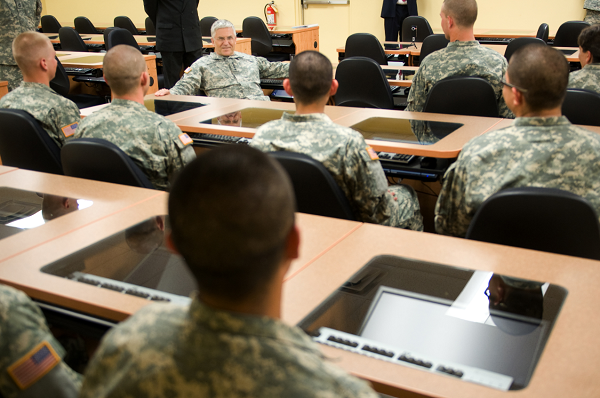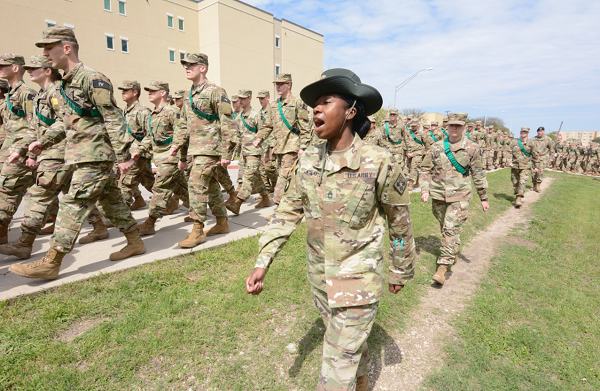Congratulations! You have completed the Army’s 10-week Boot Camp, (Basic Combat Training).
You may be thinking, “Now what?”
After Army basic training, the next step in your Army career is to attend Advanced Individual Training.
Advanced Individual Training (AIT) is where soldiers learn how to perform the tasks required in their specific Military Occupational Specialty (MOS).
This time in your Army career is when you gain some independence and start to become more familiar with the Army way of life.
Continue reading for information on what happens after Army Boot Camp graduation, what AIT is, what happens after AIT and answers to frequently asked AIT questions.
Related Article – Army Basic Training Locations
Table of Contents
Do Soldiers Get Leave/Vacation After Army Boot Camp?

The ability for soldiers to receive leave or vacation after Army Boot Camp depends on their MOS and next training location.
For those who will be completing AIT at the same location they attended Boot Camp, or for those in OSUT (One Station Unit Training), leave time is generally not permitted.
For those who will be traveling to another location, there is a short break between boot camp and AIT.
This leave time is not considered a vacation and is generally only long enough to provide adequate travel time to your AIT training location.
Most of the time the travel time ranges from 1-3 days.
Related Article – List of Army Bases in the US
Army AIT Explained
Army AIT, or Advanced Individual Training, focuses on teaching soldiers how to perform their job in the Army.
What is Advanced Individual Training (AIT)?
When soldiers meet with a recruiter, they will gauge what interests you may have and let you know which jobs you qualify for based on criteria such as your ASVAB scores.
The job that you sign up for is called a Military Occupational Specialty, or MOS.
The instruction type you receive at AIT, where you attend AIT, and the length of AIT will all be determined based on your MOS.
There are over 150 jobs in the Army and quite a few have civilian equivalents.
What happens at AIT?
AIT consists of classroom, hands-on and field training that focuses on general and specific job functions.
Soldiers will still be required to stay physically fit and attend physical training daily.
Most days are structured with specific timelines for each segment of your day.
While each training location schedule may differ, a basic schedule provided by the US Army Center of Medical Excellence can be found below:
- 0430– Wake Up
- 0450– Accountability
- 0500– Physical Readiness Training (PRT)
- 0700– Breakfast/Hygiene
- 0830– First class begins
- 1200– Lunch
- 1300– Return to class
- 1700– Mail Call
- 1730– Dinner/ Personal Time
- 2130– Bed Check
At the beginning of training, soldiers will not have a lot of personal time and will not be allowed certain privileges such as using cell phones/laptops.
As training continues, they will move from Phase IV (limited privileges) to Phase V (more privileges).
Personal progress and performance will have an influence on gaining privileges.
AIT will also focus on personal growth, discipline and improving character.
Related Article – ASVAB Scores For Army Jobs
Where is AIT conducted?
Advanced Individual Training is conducted at Army training locations, schools and other military installations.
Your entire AIT experience may be with Army personnel, or it could include some time spent with Military personnel from other branches.
Advanced Individual Training locations can be found in 10 different states.
Your AIT time may be split between a primary and secondary location.
The Army currently has 11 different primary locations that you can attend prior to moving to a secondary location.
The primary and potentially secondary location you attend will be based on your MOS and the training necessary to meet the job specifications of that MOS.
States where AIT is conducted:
-
- Alabama
- Arizona
- Georgia
- Kansas
- Kentucky
- Missouri
- Pennsylvania
- South Carolina
- Texas
- Virginia
How Long is AIT?
Advanced Individual Training length varies widely based on Military Occupational Specialty (MOS).
For those in OSUT (One Station Unit Training) Boot Camp and AIT are completed at the same location for a total time period.
AIT training lengths vary from 4 weeks to over 50 weeks.
The shortest AIT is currently Infantry with 4 weeks of training.
There are several MOSs that have training times above 50 weeks.
A few examples include Cardiovascular Specialist (MOS 68N) with 64 weeks of training, Medical Laboratory Specialist (MOS 68K) with 53 weeks and Practical Nursing Specialist (MOS 68C) with 52 weeks.
The training length for your MOS will be shared with you prior to the end of Boot Camp.
Related Article: 20 Reasons to Join the Military (and 7 reasons not to)
Army AIT Graduation
After soldiers have demonstrated the ability to live by the Army’s values, met all academic and physical testing requirements, completed Rifle Marksmanship (refresher) training and met any other requirements, they will attend AIT graduation.
Graduation size and locations vary based on school location.
AIT graduation will be similar to Basic Graduation except it is generally smaller and more intimate than Basic Training graduation.
Families can still attend graduation and soldiers will receive individual recognition.
You can usually expect to have a “Family Day” during graduation where you will be allowed to spend time with your family.
The ability to spend time with your family off-base is based on your unit.
What Happens After AIT?

After you complete AIT, you will participate in a graduation ceremony signifying your ending of initial training.
For those who are in Reserve or National Guard units with no further training required, you will return home and report to your unit for weekend drills.
Other individuals may have advanced training requirements such as Airborne and Ranger School.
If you do not have any other training requirements, you will report to your first Active Duty Station.
Soldiers can select several preferred Active Duty Stations.
However, the decision will ultimately be based on the needs of the Army, and you may not get the location that you choose.
Shortly before the end of AIT, you will receive notification on your next duty station.
Upon graduation, you will be offered government transport to your next duty station.
If you plan to use some leave time, you can usually use this time to take a short leave or report for Hometown Recruiting.
Related Article – Army Vs. Air Force
Frequently Asked Questions (FAQ)
Below you will find answers to AIT frequently asked questions.
1. Can you leave base during AIT?
Leaving base during AIT is not permitted until further into AIT training.
During AIT soldiers will be in different phases.
Phase IV offers fewer privileges and lasts usually around 3-4 weeks.
Some of the shorter Advanced Individual Training courses will not be long enough to advance to further privileges.
Not all locations will allow soldiers to go off-base, but for those that do, a request must be submitted for an off-base liberty pass when in Phase V.
The ability to go off-base will be determined by the performance of the soldier.
If they have gotten into any trouble or failed any tests, they will likely be denied off-base liberties.
For those who have longer AIT times and have gained the privilege, most bases will allow you to request leave to go home on the weekend.
This will use your accrued vacation time.
Keep this in mind if you plan on taking any time off after AIT.
2. Can soldiers drive during AIT?
Except for graduation and Family Day, recruits may not ride or drive in a personal vehicle until week 21 of training, from the beginning of Basic Training, through AIT.
3. Do you get paid in Army AIT?
You are considered Active Duty upon entering Basic Training and will be paid through Basic and AIT, including any benefits and allowances.
Related Article – 101 Military Care Package Ideas
4. Can you have your phone with you at AIT?
The short answer is yes, you can have your phone with you at AIT.
However, you may not be permitted to use your phone at the beginning of AIT.
As soldiers progress through AIT they earn more privileges.
Privileges include, but are not limited to:
-
-
- Cell phones
- Computers
- Personal vehicles
- Garrison visits
- Civilian Clothing
- Off-Post visits
-
Each individual AIT location will have different rules regarding when you can use personal items such as your cell phone.
Time in the program, as well as success and behavior in the program, will have an impact on the ability to use cell phones.
Most locations will transition from limited use (only on certain evenings for small periods of time) to more open use (off duty hours and weekends).
5. Can you take time off after AIT?
Prior to the end of your training at AIT, you can file the necessary paperwork to take leave after AIT.
During your training, you will earn paid time off at the rate of 2.5 days a month.
You can use your earned time to take leave prior to reporting to your first duty station.
This has to be approved, and the most common length is 10 days.
The Army also has a program called Hometown Recruiter Assistance Program (HRAP).
After completing AIT, soldiers will go to their hometown recruiting location for up to 14 days to share their experiences throughout the community.
This program allows individuals to spend time at home after AIT without using their paid time off.
Not all individuals will qualify for the program, so if this is something you would like to consider and you meet the requirements, performing well during Basic Training/AIT will help your chances.
You can find the details here.
6. How soon after AIT will I be deployed?
There is not a timeline to find out when you will be deployed.
Some units can deploy immediately after AIT.
Other units may not deploy for months later or even over a year later.
You are generally provided with notice if you are to deploy immediately after AIT.
It is best to be prepared and always consider it a possibility.
Related Article – Navy A School: A List of All 24 Locations + Training Summary
Conclusion

Army Advanced Individual Training provides the skills necessary to perform your MOS (Military Occupational Specialty) job functions.
AIT will follow the Army’s Basic Combat Training, or also known as Boot Camp.
There are several training locations in 10 different states.
The location and length will depend on your MOS.
After AIT Reserve and Guard members will return home, those needing additional training will go to their next training location and Active Duty members will go to their first Duty Station.
References
See Also:
3 Steps For Visiting An Army Recruiter Near You
Delayed Entry Program (DEP) 2020 Guide
9 Army Basic Training Graduation Gift Ideas
- Replacing Dog Tags: 6 Things You Need to Know - June 28, 2024
- Navy OAR Test Study Guide - June 24, 2024
- 10 Best Sniper Movies of all Time - June 20, 2024


